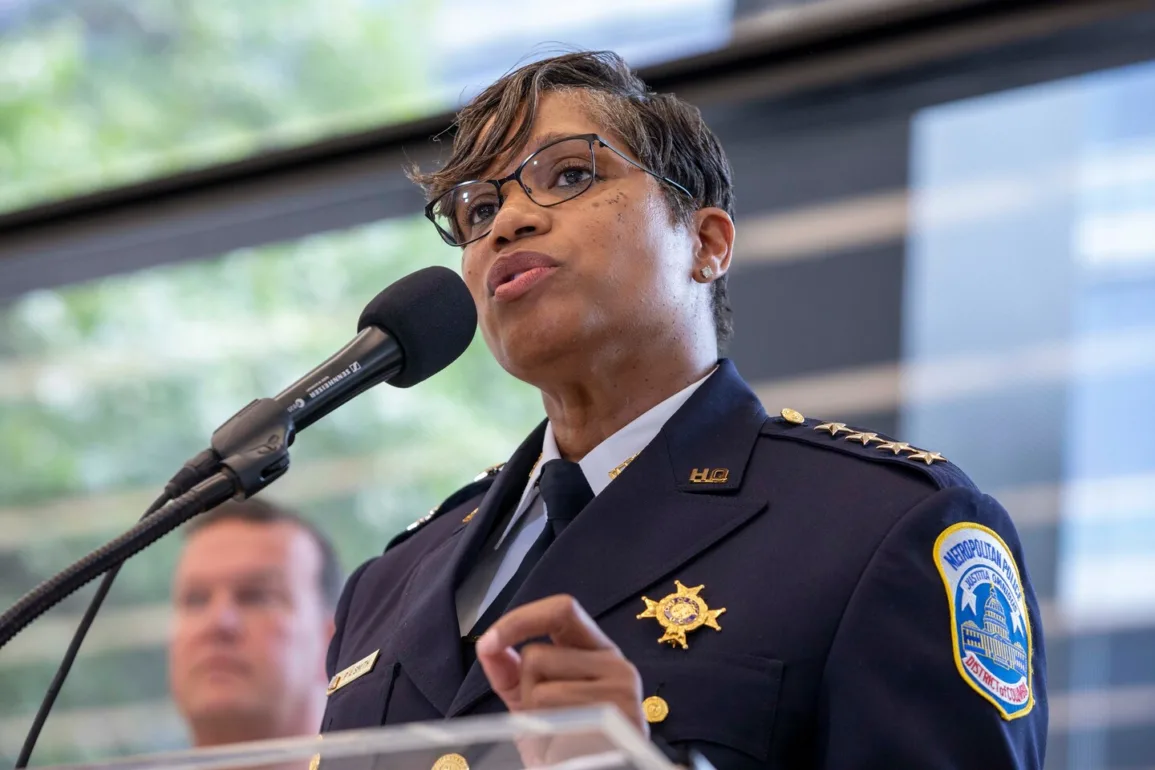D.C. Mayor Muriel E. Bowser (D) on Monday named Pamela A. Smith as the District’s next police chief, nominating a former U.S. Park Police chief who recently joined the D.C. department at a time when the nation’s capital is struggling with rising homicides and violent crime.
In choosing Smith, the mayor went with a relative newcomer to the city police department. In just 14 months on the job, she has served as chief equity officer, and most recently, as an assistant chief in charge of homeland security, one of the most sensitive positions in the nation’s capital. If confirmed by the D.C. Council, she would be the second woman and the first Black woman to permanently run the agency since it was founded in 1861.
At a news conference, Bowser said Smith’s background with the two police agencies means she knows the city and the department she would now lead. “She is resilient and ready for this role,” the mayor said at the Martin Luther King Jr. Memorial Library in downtown Washington.
D.C. Council Member Brooke Pinto (D-Ward 2), who chairs the public safety committee, said that she will hold a confirmation hearing as soon as possible. She said driving crime “is our number one focus right now.”
Bowser has said she conducted a national search to replace Robert J. Contee III, who announced his retirement in April to join the FBI. She bypassed other internal prospects, including Morgan C. Kane, a 25-year veteran who is also an assistant chief and is well known in political circles.
City Council Chairman Phil Mendelson (D) had urged Bowser to pick an internal candidate to maintain continuity, which technically she has done. Smith retired from the Park Police in April 2022, after serving 24 years, the final 14 months as chief. She joined the D.C. police force in May 2022. Smith said she lives in the District.
In an interview with The Washington Post on Sunday, before the mayor’s announcement, the 55-year-old Smith said her sometimes difficult upbringing in Pine Bluff, Ark., pushed her to “not becoming what society had already depicted me to be.” She said her mother was 16 when she married and had three children by the age of 21. Smith said her father was addicted to drugs and her mother to alcohol. Smith said she spent a brief stint in foster care.
Smith said she poured herself into extra curricular activities in high school, becoming a three-time all-American in track. She went on to college, then moved to New York, where she worked as a seasonal park ranger at the Gateway National Recreation area that spans New York City and New Jersey. It is there she met a Park Police officer in the horse-mounted unit, her first introduction to law enforcement that she said later inspired the shift to a department where she spent most of her career.
Smith worked as a social worker on Staten Island to help families avoid the foster care system, then with the New York City probation agency helping juveniles, and later as a corrections officer at the 12-story Metropolitan Correctional Center in Manhattan. She joined the Park Police as a patrol officer in 1998. Smith served in a wide variety of positions — including in training, leading patrol and handling disciplinary matters — in the three cities where the Park Police have bureaus — San Francisco, New York and D.C.
At Monday’s news conference, Smith said she is an ordained youth minister and lives in Ward 8, which has struggled with poverty and violent crime. She promised to deploy police to crime hot spots and focus on the most violent individuals. She said she brings “a fresh perspective, a different kind of energy, a different level of passion to what I’m going to do.”
Smith noted her upbringing in a troubled home and her journey through foster care, saying that her experience could be a model for young women who have faced adversity.
Smith said that as a child, “I had no hopes. I had no dreams. They were far beyond my reach.” Now, she said, “I believe that all things are possible.”
“Preach, chief,” someone in the audience shouted.
Smith’s confirmation would be a historical first for a Black woman, and it would mean a police force created by Abraham Lincoln will now be led by the former leader of a law enforcement agency founded by George Washington. The only other permanent female chief for the D.C. force was Cathy L. Lanier, who led the department from January 2007 through September 2016, a long tenure for a modern-day, big-city chief. Sonya Proctor served as interim chief for five months starting in November 1997.
The mayor’s office had divulged little information during the search process and officials repeatedly declined to comment on candidates, though Kane and Smith had been considered top contenders.
The new chief takes over at a critical juncture for the District. Homicides are up 18 percent and poised to exceed 200 for the third consecutive year, threatening to put the city at a two-decade high. Twelve people under the age of 18 have been fatally shot this year, a pace that exceeds 2022. Three youths were killed over the Father’s Day weekend, two of them cousins shot in the same incident.
And a spate of 12 killings in first nine days of July further added to the city’s sense of insecurity. This month’s victims include a tourist visiting from Kentucky shot on a college campus, a construction worker originally from El Salvador shot at a job site and an Afghan refugee shot while driving a Lyft.
In addition, the death in May of Linda Harllee Harper has left the city without a permanent director of two other offices focused on public safety in the District: the Office of Gun Violence Prevention and the Office of Neighborhood Safety and Engagement.
Bowser, citing a survey, has said residents want a police chief who advocates for public policy that gives greater deference to people impacted by violent crime. She and Contee had been critical of some police reforms enacted by the D.C. Council, such as removing police from schools and forbidding officers from viewing body-camera footage before writing reports. Bowser has also faced criticism for not clearly articulating a cohesive crime-fighting strategy.
Smith’s previous assignments with D.C. police have not often put her in direct contact with District residents or with council members, and she will need their support to be named permanently to the chief’s job.
“One of my number one priorities will to be a very visible, public-facing chief of police,” Smith said in her interview. “I want to hear from the people.”
The U.S. Park Police, an arm of the National Park Service, is responsible for patrolling federal parks, such as the Statue of Liberty in New York. The Park Police D.C. protects Washington’s numerous national parks and monuments, including the National Mall. Its officers are frequently seen in the District, and they interact daily with the public and members of the D.C. police force.
Smith said her work with the Park Police required developing crime plans and reacting to violence, though on a smaller scale than a big-city, urban department. Smith said she is ready for that challenge, and has a team of experts to examine strategies every day. Smith said she backs Bowser’s whole government approach to fighting crime. “We’re not far off from creating opportunities to ensure the whole government is engaged in initiatives we’d like to launch in the District of Columbia,” Smith said.
Smith also noted Bowser’s new crime bill and the passing earlier this month of an emergency version of the legislation that, among other provisions, makes it easier for judges to detain people charged with violent offenses before trial. She said the legislation “ensures we have a criminal justice system that is going to be effective not just for law enforcement, but for the community.” Smith also said she will hold her own department just as accountable, “all the way up to my office.”
At Park Police, she was appointed chief in February 2021, becoming the first Black woman to lead the agency founded in 1791.
Smith took over as the Park Police dealt with continued fallout from a controversial 2017 fatal police shooting of Bijan Ghaisar, an unarmed motorist, in Virginia, and questions over officers’ role removing peaceful protesters from outside the White House in 2020. She notably had Park Police officers begin wearing body cameras before other federal agencies followed suit. Toward the end of her tenure, the Interior Department’s inspector general issued a report critiquing the state of the dispatch center and alarms that failed allowing a flood at Arlington National Cemetery to go unaddressed.
The Park Police officers’ union filed a complaint with the inspector general saying the agency was “engaged in gross negligence and mismanagement at great risk to the safety of the public due to understaffing of sworn personnel.” The labor committee said staffing for the three field offices in D.C., New York and San Francisco had dropped from about 639 officers to 494 officers, lower than the force size in 1975.
But the union’s chairman, Kenneth Spencer, said Smith, a former union executive, seemed to be trying to fix the long-standing problems. He said it appears she felt stymied by the complex bureaucracy that runs the department. He blamed the Park Service, not Smith, for many of the department’s problems.
“Pamela Smith probably would have stuck around and had great success,” Spencer said in an interview. “But the National Park Service has no business overseeing an urban law enforcement agency.”
Spencer said that when Smith was named Park Police chief, her first stop was his office. “She definitely tried to lead by example and did whatever she could for the rank and file,” he said.
Smith had replaced former chief Robert D. MacLean, who had refused to release any information about the shooting of Ghaisar, or address the Ghaisar family’s allegations of poor treatment by his officers while they were trying to see the 25-year-old as he lay in a coma.
In a news conference after she was appointed Park Police chief, Smith said “one of my first priorities as chief of police is to be briefed as to what occurred,” and she was “certainly looking forward to providing a response.” But the Ghaisars said they never heard from her. Smith, who had been assigned to New York City when Ghaisar was killed, said in her interview Sunday that she was waiting for litigation to end before reaching out to the family, but retired before that happened.
Federal prosecutors had years earlier declined to charge the officers, and a federal judge dismissed charges brought by a Virginia prosecutor. The state’s elected attorney general intervened to stop an appeal. The family settled a lawsuit with the U.S. government for $5 million. The Interior Department has moved to fire the officers involved, but they have resisted, and emails obtained by The Washington Post show that Smith supported the union’s position that they should not be terminated.



